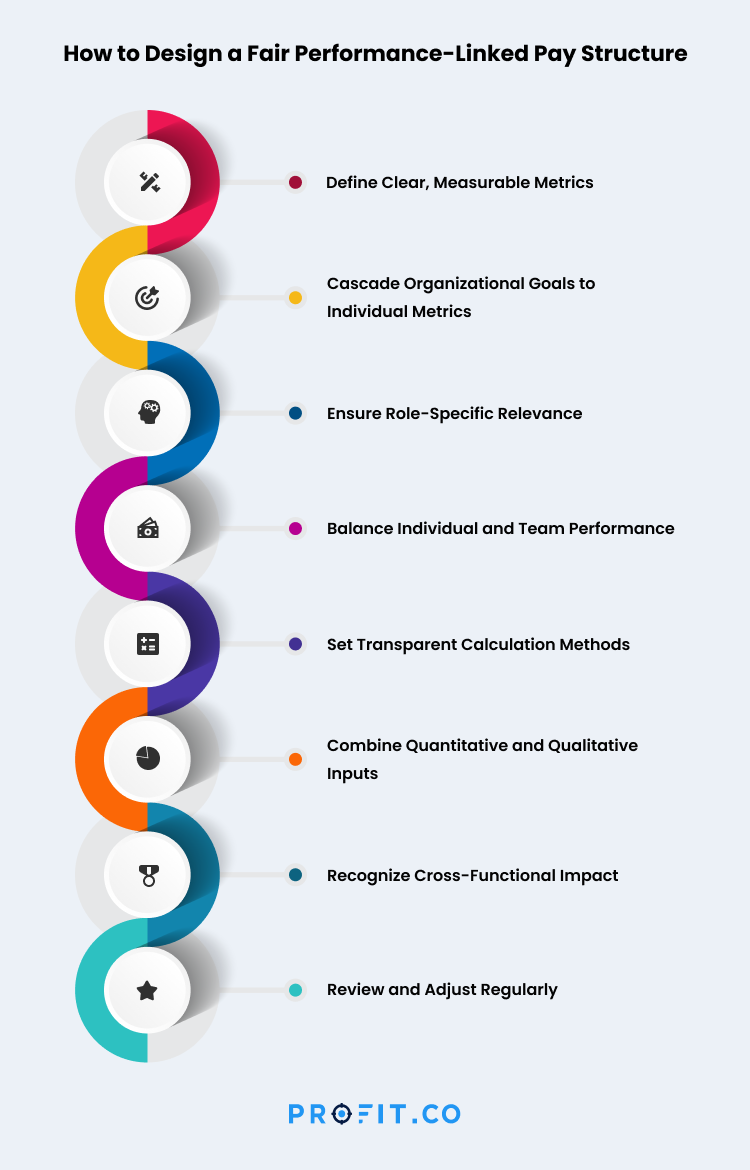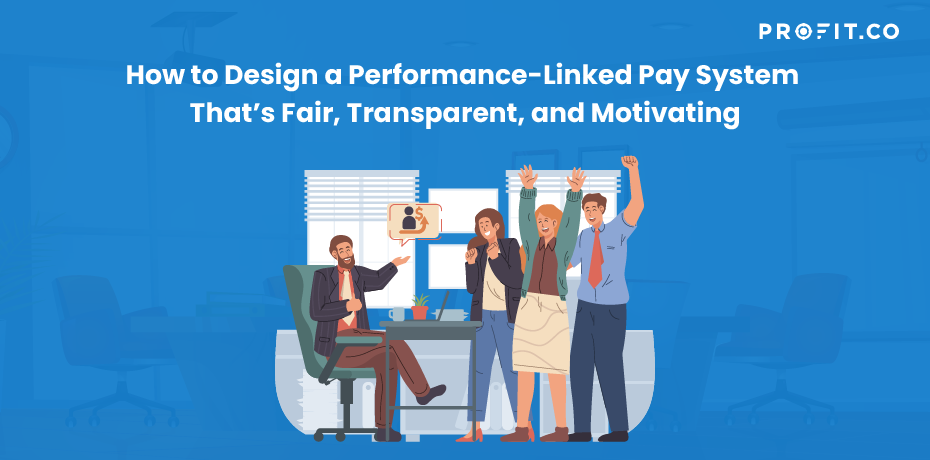That’s the essence of performance-linked pay, in a nutshell. It’s not about just dangling carrots in front of employees like they’re racehorses. Done right, it’s actually a structured way of rewarding outcomes that drives business success.
That’s because it turns compensation into a story, and one where individual effort connects directly to organizational results.
Performance-based compensation, if designed poorly, can backfire spectacularly. Employees will see it as unfair, and they’ll chase short-term gains at the expense of long-term value, or worse, they’ll game the system entirely.
So, how do you build a performance incentive plan that actually motivates people while keeping the system fair? How do you prevent it from becoming yet another buzzword-heavy HR initiative?
The answer lies in combining strategy, psychology, and fairness into something that makes sense to both employees and leaders.
Key Takeaways
- Performance-linked pay connects effort to reward. Employees see a direct impact between performance and earnings, boosting motivation and accountability.
- Fairness and transparency matter most. Clear metrics, visible formulas, and timely feedback build trust and prevent resentment
- Align compensation with strategy. Link pay metrics to organizational goals to ensure every role contributes to business growth.
- Balance individual and team incentives. Blend personal performance rewards with team-based outcomes to sustain collaboration.
- Review and adapt regularly. As business conditions change, recalibrate metrics to keep the system relevant, fair, and motivating
What Is Performance-Linked Pay?
Performance-linked pay, which is also known as variable compensation, merit pay, or incentive-based pay, is basically a model where a portion of an employee’s earnings is tied to how well they perform against agreed-upon metrics.Unlike fixed salary systems, where you earn the same no matter what, performance-based compensation introduces movement. If performance goes up, so does pay. If it declines, the increase disappears.
Think of a sales rep working on commission. They know exactly how much every deal adds to their paycheck. But it doesn’t stop there. Developers might earn bonuses for reducing bug counts or delivering features ahead of schedule.
Project managers also might see rewards tied to bringing in a project under budget. Leaders may have their compensation linked to revenue growth or profitability. At every level, performance becomes measurable and rewarding.
If you strip away the buzzwords, performance-linked pay rests on four principles.
- Transparency means employees understand the rules of the game. There are no mysterious formulas
- Alignment means the metrics are tied to what actually matters to the organization
- Fairness is what ensures that people are not penalized for things outside their control.
- Timeliness is about closing the gap between action and reward. Recognition that arrives six months late does not feel like recognition at all
Why Performance-Linked Pay Matters for High-Performance Culture
When employees know their effort is tied to their earnings, accountability becomes natural.The Business Impact of Engagement Culture
The system itself encourages people to care about results. But the real win is in motivation. Most people don’t wake up excited to “just do their job.” They want to make an impact and to see their work recognized in tangible ways. A performance incentive plan answers that desire. It builds a feedback loop where effort and outcome and reward are all tightly connected.One overlooked benefit of performance-linked pay is in the way that it connects individuals to the bigger picture. Instead of feeling like their work vanishes into a black hole, employees can see how their specific performance moves the organization forward.
When a marketing associate boosts conversion rates, or when a customer success agent improves retention for that matter, they can then see the link between their numbers and the company’s growth.
That connection is what breeds loyalty, because people want to feel like they matter.
How to Align Compensation with Strategic Objectives
Imagine a company whose strategic goal is to expand into a new market. Sales KPIs could measure new accounts in that region, marketing KPIs could measure leads generated, and product KPIs could focus on localization.Linking pay to those objectives is what will ensure that everyone rows in the same direction.
1. Cascade Organizational Goals to Individual Metrics
One reason compensation systems fail is because employees can’t connect the dots between their goals and company strategy.Cascading solves this. When the CEO sets objectives, those cascade down into department goals, then team goals, then individual metrics. A customer support agent might not think they’re affecting market expansion, but if their metric is “increase retention by solving issues faster,” suddenly they’re part of the story.
2. Balancing Individual and Team Performance
This is the balancing act most companies get wrong. If you tie pay entirely to individual metrics, you risk creating a cutthroat culture where collaboration dies. If you tie it only to team performance, you risk free-rider problems.The smart approach is to design a blend. Maybe 60% of variable pay is tied to individual outcomes, while 40% depends on your team’s success.
That way, employees stay accountable for their own work but they also really care about collective wins.

How to Design a Fair Performance-Linked Pay Structure
Metrics should be specific, measurable, and within someone’s control. A software engineer shouldn’t have pay tied to company revenue, which is too distant.Instead, their compensation might depend on code quality, feature delivery timelines, or reduction in system downtime. If metrics are vague or outside of an employee’s influence, frustration is inevitable.
Setting Transparent Calculation Methods
Imagine working all year and then getting a mysterious bonus with no explanation. That doesn’t feel like motivation. It feels like luck.The math behind variable pay has to be transparent. If an employee knows their targets and the formula, they should be able to predict their payout themselves. Transparency prevents suspicion, and it also keeps trust intact.
Recognizing Cross-Functional Contributions
Not all contributions show up in neat numbers. Sometimes the person who saved the project was the one who stepped in to collaborate across departments. Sometimes it’s the team lead who mentored juniors and raised overall performance.Performance-based compensation should leave room for recognizing these less tangible contributions; otherwise you risk devaluing critical but invisible work.
What Are the Types of Performance-Linked Compensation?
Bonuses tied to performance are the most familiar form of variable pay. These are often tied to annual or quarterly reviews. The danger here is that annual bonuses may feel disconnected from the effort that earned them.That’s why more companies are experimenting with quarterly bonuses, since faster feedback means stronger motivation.
Sales teams have consistently relied on commission as a key motivator. But the structure matters. A flat commission on all sales might encourage reps to push easy deals, while tiered commissions (higher rates for exceeding quotas) can drive ambitious performance.
The key is balance: too aggressive, and it can foster unethical selling; too soft, and it won’t move the needle.
For project-heavy organizations, tying pay to milestones just makes sense in most cases. Imagine a consulting team promised a payout if they deliver a project under budget and ahead of schedule. This structure motivates teams to collaborate effectively, because everyone’s compensation depends on collective delivery and not just individual tasks.
Also remember that timing shapes behavior. Annual cycles allow for big-picture evaluation but can feel distant. Quarterly cycles provide immediacy, but they also risk focusing too much on short-term gains.
A hybrid model, as in small quarterly bonuses plus an annual performance payout, often strikes the best aforementioned balance, because it is focused on rewarding both short-term wins and long-term progress
See how Profit.co turns performance into progress
What Are the Common Pitfalls and How to Avoid Them?
The fastest way to sink a performance pay system is by making employees feel the game is rigged.If targets are inconsistent, if managers play favorites, or if some roles get all the opportunities, resentment festers. Preventing this requires consistency, audits of compensation outcomes, and clear communication about why certain metrics are chosen.
When people are measured, they find ways to manipulate the measures. A call center employee might rush through calls to hit “average handle time” targets even if it damages customer satisfaction. A salesperson might overpromise to close a deal.
The fix is designing balanced scorecards that measure both speed and quality, and both when it comes to sales and customer retention.
If executives are paid solely on quarterly revenue, they may cut investments in R&D or slash budgets that support long-term growth. Short-term spikes might look good on paper, but they can also damage the future of the business.
Compensation systems should balance immediate results with long-term goals, like tying executive bonuses partly to three-year performance.
“Price is what you pay . Value is what you get”
How to Implement Performance-Linked Pay Successfully
A performance incentive plan can’t just be dropped into place. Employees need to know why it exists, how it works, and what’s in it for them. Managers need training to have difficult conversations about pay. Employees need FAQs and forums where they can ask questions.Change management basically is about making sure the rollout builds trust rather than fear.
In that same vein, trying to run a complex variable pay system on spreadsheets is asking for chaos. Organizations ultimately just need reliable platforms that integrate performance data with compensation systems.
Tools that track OKRs, KPIs, and project milestones are also important in order to provide the transparency and accuracy required for pay systems to be trusted.
When the Business Environment Changes
And when the business environment changes, so should compensation systems. Reviewing the performance-linked pay structure at least once a year will help to ensure that metrics remain relevant, that pay remains fair, and that the system continues to motivate the right behaviors.Employee feedback should be part of these reviews as they’re the ones living under the system every day!
Conclusion: Building a Culture of Shared Success
Performance-linked pay is about the story an organization tells its employees: that results matter, that contributions are valued, and that rewards are distributed fairly.In that way, it’s about connecting the individual’s daily work to the company’s long-term strategy and showing employees that when the business wins, they win too.
A well-designed performance-based compensation system is transparent, and it’s also aligned and fair. It recognizes both measurable outcomes and invisible contributions. It avoids the traps of short-term thinking, gaming, or unfairness.
And most importantly, it builds a culture where success is shared. Employees are not just working for a paycheck, they are working toward goals they believe in, and they are rewarded accordingly when they deliver.
Done thoughtfully, performance-linked pay ultimately transforms compensation from a routine transaction into a dynamic driver of motivation and accountability. It becomes less about salaries and more about shared success.
And when employees see that their effort directly shapes both their paycheck and the company’s future, that’s when performance pay becomes more than a system.
It becomes a part of the culture.
Discover how Profit.co can help you design fair, motivating pay systems
Performance-linked pay, also known as variable or incentive-based pay, ties part of an employee’s earnings to measurable performance metrics. The better the performance, the higher the pay
Unlike fixed salaries, which remain constant regardless of output, performance-linked pay introduces movement, rewarding measurable results and effort rather than tenure.
Transparency, alignment with company goals, fairness (metrics within control), and timely rewards are critical for success.
Set balanced scorecards that measure both quality and quantity, ensure consistent review practices, and include employee feedback in annual evaluations.
Ideally, it should be done once a year, or whenever business priorities shift, to keep metrics relevant and ensure compensation continues to drive the right behaviors.
Related Articles
-
How to Implement Dynamic Performance Management in Tech Companies
TL;DR Dynamic Performance Management helps tech companies move beyond slow, yearly reviews. It uses real-work evidence from tools like GitHub,... Read more
-
The Manager’s Guide to Dynamic Performance Conversations
TL;DR It's time for traditional annual reviews to go away. Dynamic performance conversations take the place of yearly reviews with... Read more
-
How to Course-Correct Performance Using the Performance Triangle
Every organization experiences deviations. Targets shift, priorities change, and results don't always align with the effort invested. Such variation reveals... Read more
-
How to Transform Managers from Judges to Coaches
TL;DR Traditional performance management often turns managers into judges rather than coaches, bogged down with documentation and annual ratings. Dynamic... Read more




